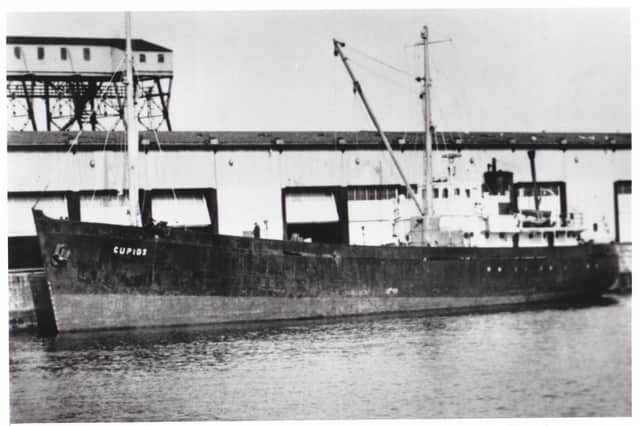Shipping Lines - Quentin Durward and Cupids – equally handy with bows & arrows


The Scottish Borders may not be the first location that comes to mind when looking for an east coast shipping connection. However, it was worth a try during a short break at Peebles over the recent New Year period. Nevertheless, a series of local signposts with place names, together with characters from the famous Waverley novels of Sir Walter Scott, recalled some of the vessels of the fleet of Geo. Gibson & Co., the former Leith-based shipowners.
Gibson’s fleet carried a wide range of cargoes to and from the Forth but also services from Dundee to France, the Iberian Peninsula but mainly to and from the Low Countries. Bales of cork from Leixoes in Portugal for floorcovering manufacturing in Dundee and Kirkcaldy was one cargo and I can remember a visit to Leith in the 1950s watching agricultural machinery which had been manufactured in Kilmarnock being loaded into the Borthwick and destined for a port in Belgium. Also, the Dryburgh served on a weekly service from Dundee to Rotterdam with general cargo and a small number of passengers. I seem to have a recollection that Geo. Gibson & Co. participated in the seasonal transatlantic trade to Canada and the Great Lakes in the early 1960s.
Advertisement
Hide AdAdvertisement
Hide AdTheir fleet consisted of a variety of ships of various tonnages, with the larger Eildon and Ronan engaged in the coal trade to south of England power stations. Among those at the smaller end were the Quentin and Durward, neither of which would be remembered for their rather drab colour schemes which included black, ochre with some white areas on deckhouses. Black painted funnels topped this livery although if I remember correctly, some of their ships carried crossed red, white and blue house flags which added a bit of colour.
The Quentin was in the news when she came to Arbroath for a cargo of damaged flax off-loaded from the rather elderly Soviet cargo steamer Krymov which was lying stranded on the beach at Murcar, a few miles north of Aberdeen. The 240-ton consignment of sodden bales which were roughly twice the weight of dry flax by then, had been loaded at Stonehaven after being discharged from the salvage steamer Nellie Laud. Dockers in Aberdeen apparently had declined to handle the damaged cargo and so it was transported south to Arbroath, a non-scheme port. A ship’s officer at the time thought it was destined for discharge at Antwerp. The Krymov was eventually towed off the sands and broken up at a scrap berth on the Forth.
The Durward came to Perth on one occasion to load a 275-ton part cargo of oats for Rotterdam in July, 1954. She had been built by Grangemouth Dockyard Company in 1939. She was sold on to Canadian owners in 1960 and reportedly sank in St. Pierre Harbour off the coast of Newfoundland as the Cupids in 1977. She was likely to have been on an inter-island voyage from nearby Miquelon.
Informed historians will of course know that Quentin Durward was the subject of a Sir Walter Scott novel which was made into a film of the same title in 1955, starring Robert Taylor, Robert Morley and Kay Kendall. A complicated tale of a Scottish mercenary, the hero of the book was supposed to have been in the employ of King Louis XI of France’s Scottish Archers’ bodyguard around 1498. In the complex story he is credited with saving that Monarch’s life from an attack by a wild boar. The original book which was written in 1823, ran to 400 pages and drew extensively on a variety of historical sources.
To be concluded.
Caption: Cupids berthed at a Canadian port.